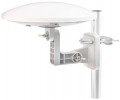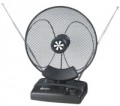Instalation type
Implied way to install the antenna.
—
Street. Models designed for outdoor use. Such an installation does not impose special restrictions on size and design, which allows to focus on technical specifications. Thanks to this, outdoor models are generally more advanced than indoor models, a properly installed external antenna allows you to achieve reliable reception even in places with a rather weak signal. Another difference from indoor models is the improved protection from dust, water and other adverse factors. Most outdoor antennas are equipped with mounts for permanent installation on a horizontal or vertical surface (such as a roof or wall).
—
Room. Antennas designed for indoor installation. Usually, they have a relatively compact size, a rather elegant design compared to their outdoor counterparts, and they are also easier to install — you just need to install the device on any suitable surface. At the same time, the specifications of such models are noticeably inferior to other types, they are suitable only for places with a high TV signal level (for example, upper floors in low-rise buildings and a small distance from the repeater). And even in such cases, in order to achieve reliable reception, it may take a long and troublesome search for the optimal location for the antenna.
Amplification coefficient
The amount of received signal amplification provided by the antenna. The higher this indicator, the more confidently the antenna will work in conditions of poor reception, the lower the signal level at which it will be ineffective. At the same time, it is worth considering that a high amplification coefficient is not a guarantee of high quality. Firstly, unscrupulous manufacturers and sellers may indicate figures in the specifications that do not correspond to real indicators. Secondly, the antenna amplifies not only the useful signal, but also various interferences, and in some cases a low amplification coefficient is preferable (for example, in dense multi-storey buildings, when the signal reaches the antenna from different directions and with different delays). And thirdly, performance above 40 dB can only be achieved using amplifiers (see below) — and amplifiers are also a source of noise, which in some situations can be quite noticeable.
VHF frequency range
The frequencies in the VHF range for which the antenna is designed. VHF includes frequencies from 30 to 300 MHz antennas with full coverage of this range are quite rare, but this is not required, because TV broadcast frequencies occupy only a part of VHF, and this part usually overlaps quite well.
Antenna sellers generally choose to sell models that are compatible with local frequencies. Therefore, in general, the frequency range is a rather specific parameter that the average user rarely needs — except when buying an antenna in another country. Also note that FM broadcasting in Europe and America uses the 87.5 – 108 MHz range, and antennas for such broadcasting (see "Signal Reception"), by definition, must cover these frequencies.
Output impedance
The internal resistance of the antenna to alternating current. The standard value for modern TV antennas is 75 ohms; it is this impedance that the connecting cable used to connect the antenna to the receiver should have — otherwise there can be no question of normal use.
Gain control
The ability
to control the built-in amplifier allows to stabilize the wave impedance between the antenna cable and the receiver. This prevents overloading, which in turn affects signal quality. Often, television antennas with a gain control option are equipped with their own 12 V power supply.
Cable length
The length of the connecting cable supplied with the antenna (often non-detachable). Quite a lot of models come with a cable right away, which eliminates the need to purchase it separately. And knowing the length of the cable, you can evaluate whether it is enough to reach the TV without additional cables.

